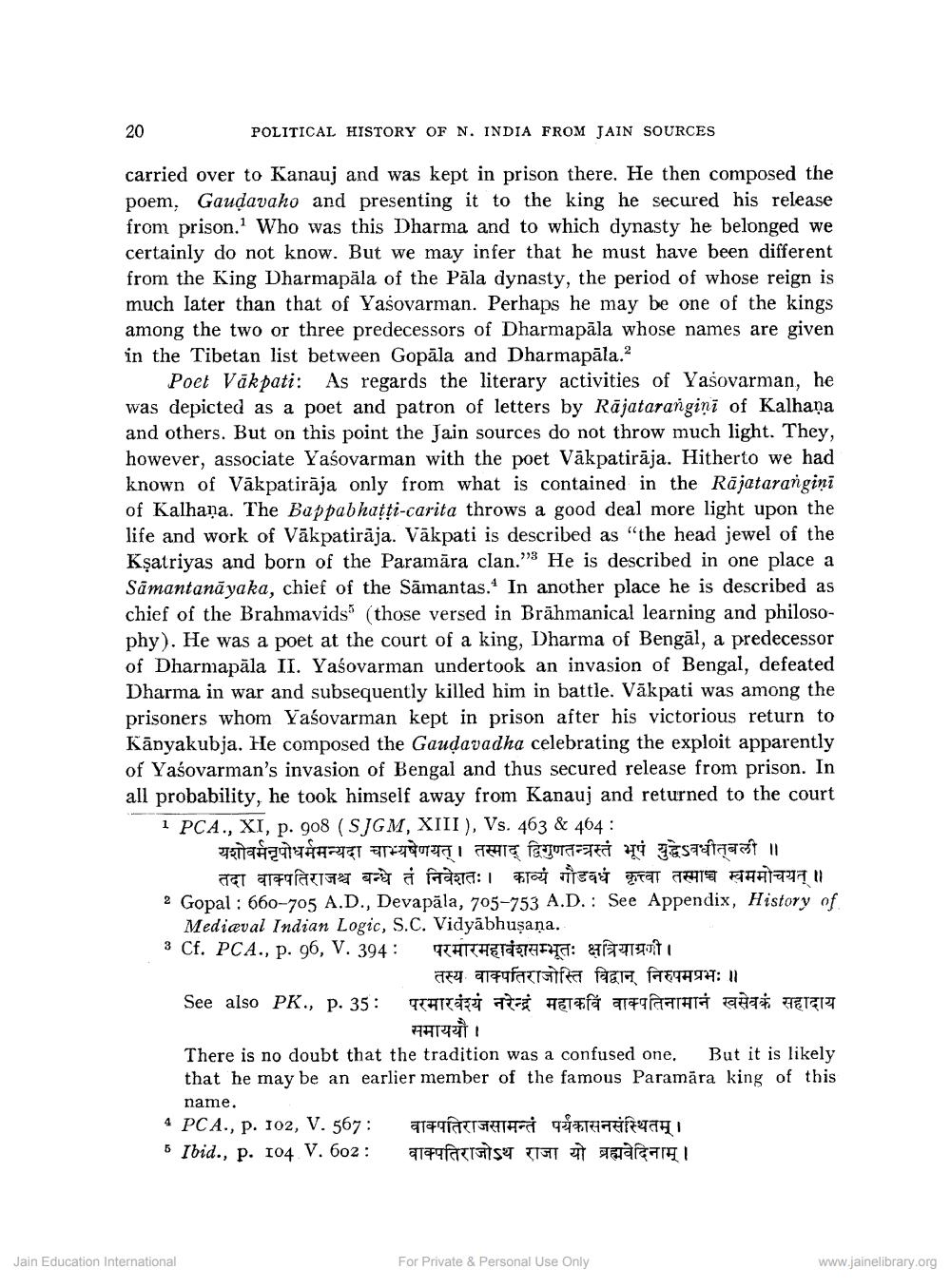________________
20
POLITICAL HISTORY OF N. INDIA FROM JAIN SOURCES
carried over to Kanauj and was kept in prison there. He then composed the poem, Gaudavaho and presenting it to the king he secured his release from prison. Who was this Dharma and to which dynasty he belonged we certainly do not know. But we may infer that he must have been different from the King Dharmapăla of the Pāla dynasty, the period of whose reign is much later than that of Yasovarman. Perhaps he may be one of the kings among the two or three predecessors of Dharmapāla whose names are given in the Tibetan list between Gopāla and Dharmapāla.?
Poet Vākpati: As regards the literary activities of Yašovarman, he was depicted as a poet and patron of letters by Rājatarangini of Kalhaņa and others. But on this point the Jain sources do not throw much light. They, however, associate Yasovarman with the poet Väkpatirāja. Hitherto we had known of Vākpatirāja only from what is contained in the Rājatarangini of Kalhaņa. The Bappabhatti-carita throws a good deal more light upon the life and work of Vākpatirāja. Vākpati is described as "the head jewel of the Ksatriyas and born of the Paramāra clan." He is described in one place a Sāmantanāyaka, chief of the Sāmantas. In another place he is described as chief of the Brahmavids (those versed in Brāhmanical learning and philosophy). He was a poet at the court of a king, Dharma of Bengal, a predecessor of Dharmapāla II. Yasovarman undertook an invasion of Bengal, defeated Dharma in war and subsequently killed him in battle. Vākpati was among the prisoners whom Yasovarman kept in prison after his victorious return to Kānyakubja. He composed the Gaudavadha celebrating the exploit apparently of Yašovarman's invasion of Bengal and thus secured release from prison. In all probability, he took himself away from Kanauj and returned to the court 1 PCA., XI, p. 908 (SJGM, XIII), Vs. 463 & 464 : ___ यशोवर्मनृपोधर्ममन्यदा चाभ्यषेणयत्। तस्माद् द्विगुणतन्त्रस्तं भूपं युद्धेऽवधीत्बली ॥
तदा वाक्पतिराजश्च बन्धे तं निवेशतः। काव्यं गौडबधं कृत्वा तस्माच्च स्वममोचयत् ॥ 2 Gopal : 660-705 A.D., Devapāla, 705-753 A.D.: See Appendix, History of
Medieval Indian Logic, S.C. Vidyābhuşaņa. 3 Cf. PCA., p. 96, V. 394: TATTHETITFHT: TATTI
तस्य वाक्पतिराजोस्ति विद्वान् निरुपमप्रभः ॥ See also PK., p. 35: TARIM TE HET AT TATA * TETEN
समाययो। There is no doubt that the tradition was a confused one. But it is likely that he may be an earlier member of the famous Paramära king of this
name. 4 PC A., P. 102, V. 567: JETTATA THERYTHI 5 Ibid., p. 104 V. 602: 9799ATTS (TET I g arai
Jain Education International
For Private & Personal Use Only
www.jainelibrary.org




